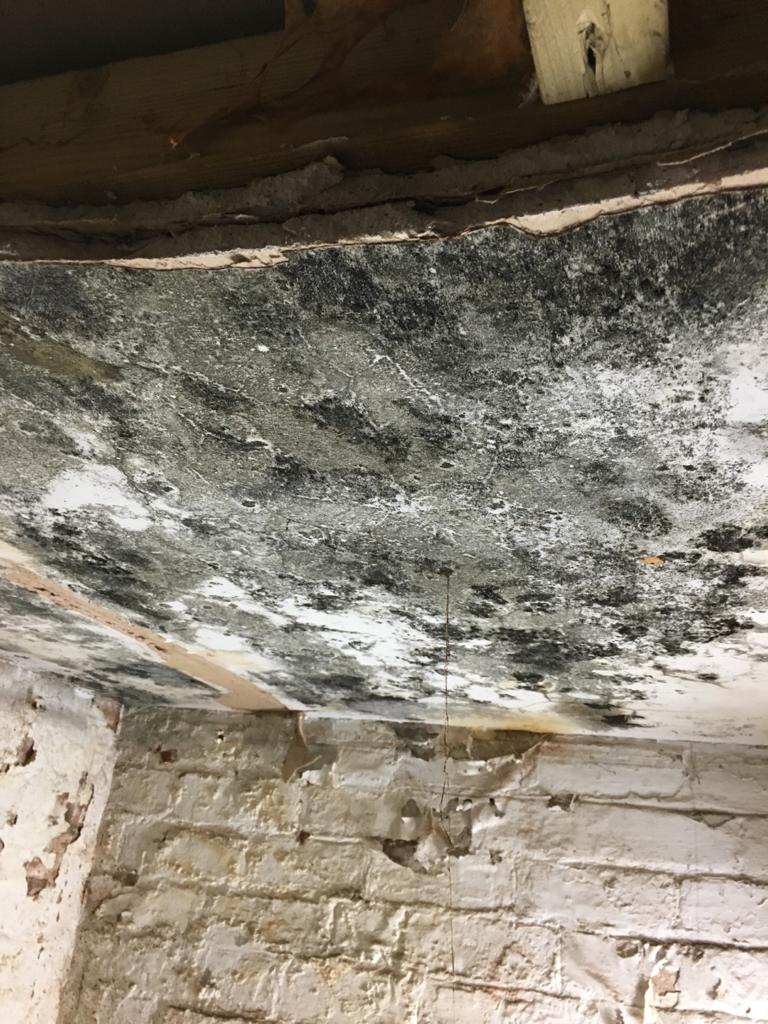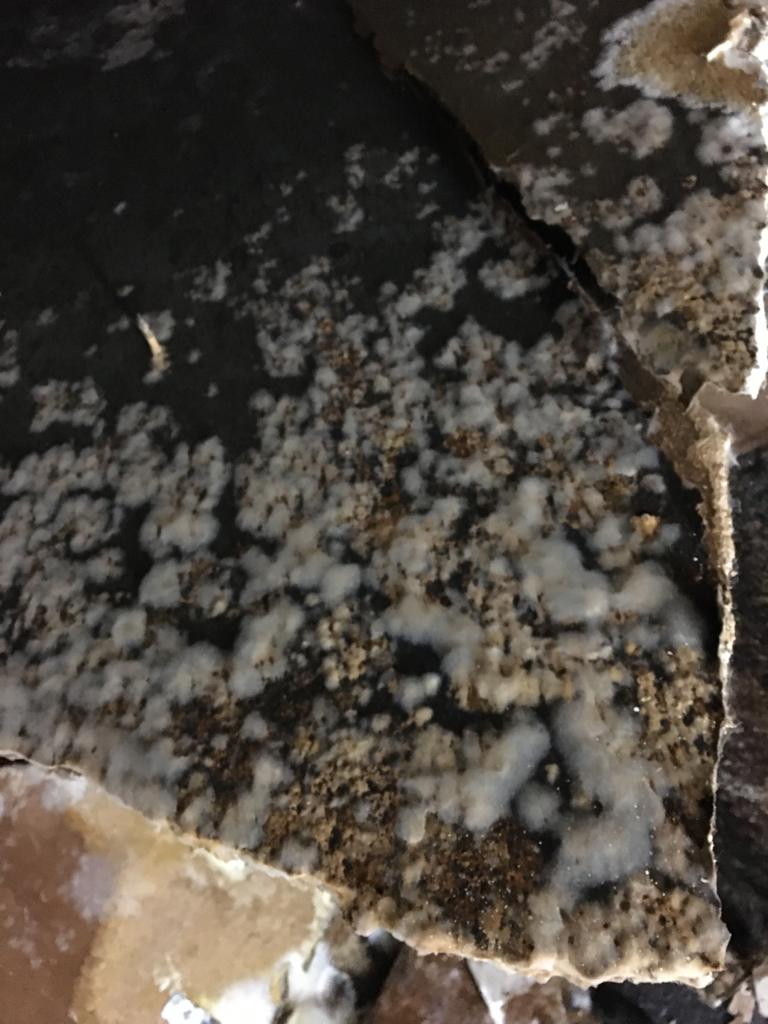Ideal tackles mould and health risk
Mould remediation, West Midlands Summary
Client: Charitable property owner in Stourbridge
• Mould removal in West Midlands
• Danger of mould and impact to health for residents
• 4-stage mould decontamination
• BioSweep® and dehumidification of basement
The Challenge
Mould can quickly develop and be a serious impact on health unless remediation is carried out rapidly. For our client – a charity which supports adults with learning and other disabilities – the issue of mould growth remained undiscovered for some time at a property which they owned and rented to adults in need.
The property, called Garlon House, comprised a number of flats and a basement, used primarily for storage, which had not been tanked. Water had leaked through the suspended ceiling of the basement creating a high volume of abnormal microbial growth on all surfaces, walls, and the remaining ceiling, which had fallen in many areas – a mould removal Stourbridge service was needed.
While there was no cause for concern in the upstairs of the property, the results of the Ideal Response Team’s analysis, moisture assessment and visual mould inspection highlighted the extent of the mould proliferation, and the speed at which it was spreading. Our challenge was to quickly reduce the impact to health and safety, negate the ‘indoor environmental impact’, plus of course, reduce the financial impact of continuing water leakage and the ongoing health risk as mould built up.
The Ideal Solution
To understand the severity of the microbial growth, Ideal sent a technical project manager to survey the basement of Garlon House and estimate the work to be carried out.
We first performed a moisture survey across the ceiling, walls and floors of the basement, and found high readings which were deemed beyond acceptable. An extensive remediation and drying regime was then proposed and accepted by our client in order to minimise the very clear danger to health and safety and ensure complete mould removal.
Following the survey, our team arrived to perform their mould cleaning service, and sheeted off communal hallways to prevent the migration of airborne mould spores (and other airborne) particulates. We also installed a decontamination chamber outside of the entrance to the basement stairs, to avoid contaminating communal areas and ensure we had a safe exit to remove mould-infected materials.
The Ideal team then removed all materials stored in the basement, dismantled and removed the ceiling, and stripped back certain areas of the basement, which revealed mould growth to the internal partition walls and plasterboard finishes. Although these were considered to be secondary damage, our team knew that mould would continue to flourish there, and so these areas were included in the remediation plan.
We then performed our standard 4-stage mould remediation and mould removal programme. Firstly, the team removed surface mould growth with a high-density HEPA-rated vacuum system. We then washed down the plasterboard, plyboard and other affected materials within the basement, and applied a specially formulated fungicidal barrier which kills mould at the root and prevents further growth. The final step in the mould removal process was Ultra Low Volume (ULV) fogging which generates a mist of ULV droplets to remove any airborne particles and eliminate musty smells from interior spaces.
With our specialist mould removal in the Stourbridge property completed, the Ideal team performed its regular ozone decontamination process (BioSweep) and installed 2 refrigerant dehumidifiers and 2 turbo air movers as part of a drying programme to stabilise environmental conditions in the property and remove excess moisture from the structure of the building.
This comprehensive and professional approach to mould removal ensured that residents of Garlon House no longer faced a risk to their health, and the dangers of mould within the basement would not return.


The dangers of mould to human health
Mould is not only unsightly and causes an unpleasant smell: it can also have adverse health effects by causing or worsening respiratory problems, infections, allergies or asthma. The impact to the health of mould should never be underestimated – the Housing Health and Safety Rating System (HHSRS) states that mould is a Category 1 risk – giving it the same risk factor as asbestos.
Mould spores are typically always present in the atmosphere inside and outside of a property. But when damp, humid conditions provide the environment for the mould spores to thrive, the risk to human health becomes proportional to the exposure time to mould; the type of mould; and the density of airborne spores.
Mould growth will not go away by itself, especially if food (obtained from the surface the mould lands on, such as wallpaper or paint), moisture, humidity and oxygen are present. Mould is a living organism and must be killed in order to be removed, at which point condensation in the property – or the ingress of water – must be halted to prevent the return of mould.
Whether your mould infestation comes as the result of flooding or general damp and moisture in your property, Ideal can help by rating the contamination level according to the size of the affected area, and providing appropriate response so that the mould growth cannot get out of control. We offer a 24-hour callout service for mould remediation and damage caused by black and toxic mould, and we have over ten years’ experience in dealing with mould, making us the expert, professional choice
The Technical Bit
Moulds typically develop and flourish in and on materials where there is water activity, be it through a direct soaking; moisture penetrating materials, or hygroscopic materials absorbing moisture from the atmosphere.
Before removing mould, Ideal carries out a condensing survey to measure the temperature of the walls and air dewpoint (the temperature at which condensation occurs) which allows us to estimate the extent of the fungal proliferation and the level at which it is spreading.
Our mould remediation treatment for Garlon House then took take place in four stages:
1. We used a HEPA-rated vacuum system to remove surface mould growth. Unlike domestic appliances, this specialist vacuum system traps mould spores so that they cannot become airborne. Waste materials are then treated prior to being double bagged for safe removal and off-site disposal.
2. We treated plasterboard, plyboard and other affected materials with a broad-spectrum biocide solution called D7. This specialist chemical targets and eradicates the mould spores and allows for a safe and thorough manual clean. All of D7’s ingredients are listed on the US FDA’s GRAS list (Generally Regarded as Safe) and are commonly used in food processing and other industries for sanitation purposes. An added advantage of D7 is that it was developed and engineered to eliminate/inactivate DNA and RNA, which means it prevents an organism’s re-growth and its ability to build resistance.
3. We applied a fungicidal barrier to kill mould at the root and prevent further mould growth. This was applied by brush, extending the treatment one metre beyond the area of visible infection. Special attention was given to corners and junctions in the affected areas to ensure proper coverage. After completion of the first coat, a second coat was applied and left to dry.
4. We used Ultra Low Volume (ULV) fogging, which releases a fine mist of the antimicrobial/broad spectrum biocide into the air, targeting any non-visible, airborne mould spores. If these were not eradicated, they could return to hard surfaces and allow a future ingress of mould, with the associated impact to health and safety.
The Ideal Response Team then deployed BioSweep, our ozone decontamination process which permanently eradicates indoor bio-contaminants and volatile organic compounds including fungi and fine particulate matter such as aerosols, smoke, fumes, dust, ash and pollen. The system combines the latest in contamination destruction technology in one portable unit to produce unparalleled decontamination and restoration capabilities on-site. The process is low-temperature, residue-free and is safe for use on all materials.
Finally, we introduced a drying programme of dehumidification in the basement with success judged by internal conditions being at, or better than, normal room conditions. Air and surface sampling was undertaken before, during and after the remediation process to validate that mould removal had been successful and that moisture levels were acceptable. The basement of Garlon House is now fit for use, with its residents protected from the dangers of mould.



